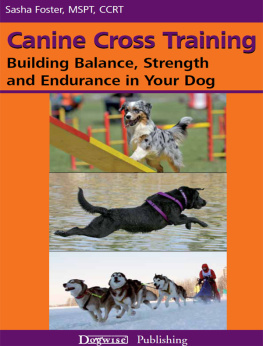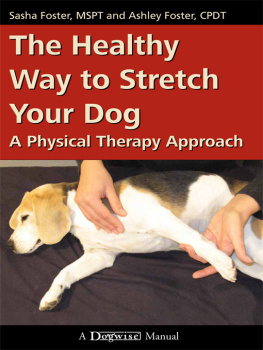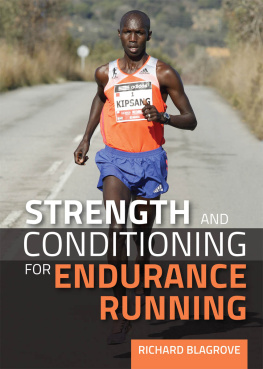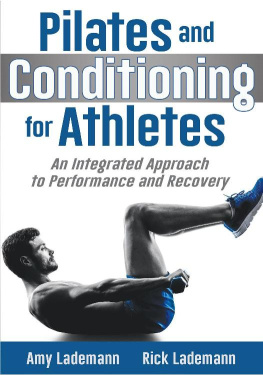
Canine Cross training
Building Balance, Strength and Endurance in Your Dog
Sasha Foster, MSPT, CCRT
Dogwise Publishing
A Division of Direct Book Service, Inc.
403 South Mission Street, Wenatchee, Washington 98801
1-509-663-9115, 1-800-776-2665
www.dogwisepublishing.com / info@dogwisepublishing.com
2013 Sasha Foster
Photos: Sasha Foster
Graphic Design: Lindsay Peternell
All rights reserved. No part of this book may be reproduced or transmitted in any form or by any means, electronic, digital or mechanical, including photocopying, recording or by any information storage or retrieval system without permission in writing from the publisher.
Limits of Liability and Disclaimer of Warranty:
The author and publisher shall not be liable in the event of incidental or consequential damages in connection with, or arising out of, the furnishing, performance, or use of the instructions and suggestions contained in this book.
Library of Congress Cataloging-in-Publication Data
ISBN: 978-1-61781-113-5
Printed in the U.S.A.
More praise for Canine Cross Training
This is a comprehensive, detailed source for targeted canine exercises. Its thoughtfully conceived and well-writtenan essential goto guide.
M. Christine Zink DVM, PhD, DipACVP, Professor and Director Department of Molecular and Comparative Pathobiology, Johns Hopkins University School of Medicine, author of The Agility Advantage and Peak Performance.
To Quin
Black fur shining, running in the bending green reeds
beside cool high mountain streams, you taught me to love
with dedication so deep it rooted me to the world. May
you always have smooth wet stones on which to rest your
belly and fields of fresh bright snow.
I miss you, Boo.

This book would not have been possible without the tremendous dedication and hard work of the following people: Ashley Foster, who works effortlessly by my side reminding me to see the world through the eyes of the dogs; Pam Foster and Jim Simos, my parents, for guiding me with your experience; Dr. Jana Dean, Dr. Greg Burns, Dr. Rainey Corbyn and the staff at South Mesa Veterinary Hospital and Come, Play, Stay in Fort Collins, Colorado, for your continued dedication to impeccable veterinary medicine, animal rehabilitation, and boarding and daycare services; all Canine Fitness Zone clients, for your wonderful feedback helping me better understand how to help you provide research-based care for your dogs; Sarah Stremming, for editing again and again and sharing ideas that made this book better; Craig Miles and staff, for your tremendous dedication to my business; Steve Carroll, for teaching me the language of numbers; to the Larimer County Small Business Administration including Jim McWilliams, for turning a book into a business; Monica Wilson, for being Quin and Mimzys friend and companion while Im off sharing ideas with the world; Yvonne Hanning, mother of May, for editing and superb feedback on the original manuscript; Ashley Eike, for citation editing; Ellie Bennett, for prepping the manuscript; Corrine Glulick, for creating forms in the eleventh hour; and all the people who believe that dogs deserve the highest quality research-based care available. Your efforts are greatly appreciated.

The brain of a physical therapist is an interesting place. Trained to see with our hands and calculate with our eyes, our observation skills become honed to the point where we cant turn them off. The dog pacing in the park has back pain, that agility dog has limited hip range of motion and this old dog has a sore right knee. Of course, unless asked, we generally keep these constantly trolling thoughts to ourselves. But the point is that our senses are trained to see movement and our brains are trained to do something about it. Furthermore, when we make recommendations, be it a conditioning program for a healthy dog or a physical therapy treatment for an injured dog, we should always have a good physiological reason for choosing each little thing that we do. Making decisions based on the bodys natural processes is part of the art of physical therapy. Healing and wellness occur because we understand how to facilitate the bodys inherent wisdom. Knowing how best to use the bodys natural processes to promote wellness and healing is the basis of canine cross training.
When I decided to start Canine Fitness Zone, the goal I set was to build a cross training program based on well-founded physiological principles and primary research. The result was a program I call the 4-Tiered Canine Athletic Conditioning Program which forms the basis of this book. Not only did I want to improve the physical performance of dogs through cross training, I also wanted to use only positive, reward-based training methods that would teach not just exercises for dogs, but would modify their bodies so what they learned in our dog gym would carry over into life. I quickly learned that creating exercises was fairly easy. Creating exercises that humans could teach dogs to do with good form following the neurological principle of motor learning was another thing all together. Youll read all about motor learning in .
The process of canine exercise development is an intellectual challenge that requires humor and patience. In the beginning, as I did my research and developed new exercises, I would get all excited about it and run to the dog trainers, Ashley and Sarah, at South Mesa Vet Hospital in Fort Collins, Colorado where my original physical therapy clinic is located. Id say Hi, how do I get a dog to side step onto a six inch box with his back legs without touching him in any way? Theyd look at me and shake their heads as I pulled the box out and hoped someone would let me borrow their dog. Together we would sit on the floor and work out not just how the exercise should be done from a physical therapy perspective, but how the exercise should be done from the dogs perspective. We challenged each other to think better, harder and outside the box. In the process we helped Sarah develop a new method for agility running contacts. We also threw down a few challenges, for example, First one to teach her dog to climb up a wall backwards wins! (Check out the Canine Fitness Zone channel on YouTube to see which dog won.) In time we became very good at putting our brains togethera physical therapist/certified pet dog trainer brain fusion that created foundation exercises and behaviors to safely and effectively execute the movements. The program presented to you here is what was created in this process. It is founded on conditioning research and created with a dogs physical, mental and emotional terrain in mind.
The research used to develop this program spans many years and multiple species. Opossums were kind enough to teach us how quadruped muscles store energy for movement. Rats and cats taught us most of what we know about nerves. Humans showed us how muscles respond to strength training. And dogs, bless their hearts, taught us about the canine cardiac response to exercise. Together this wonderful body of research was a good starting point for designing our canine cross training program.
But please understand, just as the 4-Tiered Canine Athletic Conditioning Program frequently undergoes modifications, the information presented in this book will need to change as well. As the body of canine-specific research grows in the emerging field of animal rehabilitation, we expect to learn things we simply do not know now. Please forgive the mistakes I dont know Im making today. Rest assured I will continue to update this work to bring your dogs the highest quality, research-based, physical-therapy-brained conditioning programs currently available.
Next page











